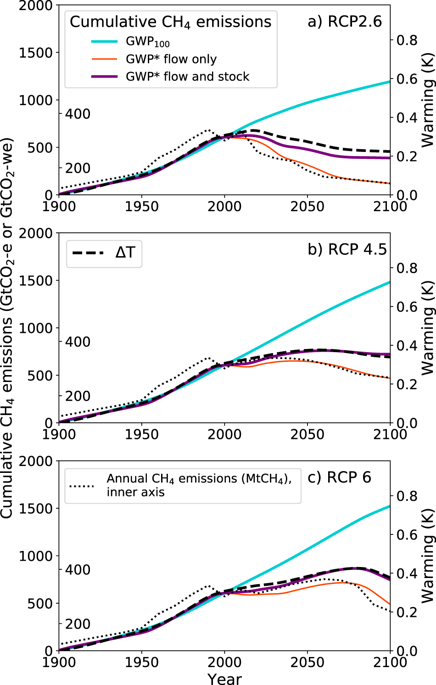npj Climate and Atmospheric Science ( IF 8.5 ) Pub Date : 2019-09-04 , DOI: 10.1038/s41612-019-0086-4 Michelle Cain 1, 2 , John Lynch 3 , Myles R Allen 1, 3 , Jan S Fuglestvedt 4 , David J Frame 5 , Adrian H Macey 6, 7

|
Anthropogenic global warming at a given time is largely determined by the cumulative total emissions (or stock) of long-lived climate pollutants (LLCPs), predominantly carbon dioxide (CO2), and the emission rates (or flow) of short-lived climate pollutants (SLCPs) immediately prior to that time. Under the United Nations Framework Convention on Climate Change (UNFCCC), reporting of greenhouse gas emissions has been standardised in terms of CO2-equivalent (CO2-e) emissions using Global Warming Potentials (GWP) over 100-years, but the conventional usage of GWP does not adequately capture the different behaviours of LLCPs and SLCPs, or their impact on global mean surface temperature. An alternative usage of GWP, denoted GWP*, overcomes this problem by equating an increase in the emission rate of an SLCP with a one-off “pulse” emission of CO2. We show that this approach, while an improvement on the conventional usage, slightly underestimates the impact of recent increases in SLCP emissions on current rates of warming because the climate does not respond instantaneously to radiative forcing. We resolve this with a modification of the GWP* definition, which incorporates a term for each of the short-timescale and long-timescale climate responses to changes in radiative forcing. The amended version allows “CO2-warming-equivalent” (CO2-we) emissions to be calculated directly from reported emissions. Thus SLCPs can be incorporated directly into carbon budgets consistent with long-term temperature goals, because every unit of CO2-we emitted generates approximately the same amount of warming, whether it is emitted as a SLCP or a LLCP. This is not the case for conventionally derived CO2-e.
中文翻译:

改进了短期气候污染物变暖当量排放的计算。
特定时间的人为全球变暖很大程度上取决于长期气候污染物 (LLCP) 的累积总排放量(或存量),主要是二氧化碳 (CO 2 ),以及短期气候的排放率(或流量)紧接在该时间之前的污染物 (SLCP)。根据联合国气候变化框架公约 (UNFCCC),温室气体排放的报告已根据 CO 2当量 (CO 2-e) 使用全球变暖潜能值 (GWP) 的排放量超过 100 年,但 GWP 的常规用法无法充分捕捉 LLCP 和 SLCP 的不同行为,或它们对全球平均地表温度的影响。GWP 的另一种用法,表示为 GWP*,通过将 SLCP 排放率的增加等同于 CO 2 的一次性“脉冲”排放来克服这个问题. 我们表明,这种方法虽然改进了传统用法,但略微低估了最近 SLCP 排放量增加对当前变暖速率的影响,因为气候不会立即对辐射强迫做出反应。我们通过修改 GWP* 定义解决了这个问题,该定义为辐射强迫变化的每个短时间尺度和长期气候响应包含了一个术语。修正后的版本允许“CO 2 -warming当量”(CO 2 -我们)的排放量直接从报告的排放计算。因此,SLCP 可以直接纳入符合长期温度目标的碳预算,因为每单位 CO 2- 无论是作为 SLCP 还是 LLCP 排放,我们排放的温室气体都会产生大致相同的变暖量。对于常规衍生的CO 2 -e ,情况并非如此。











































 京公网安备 11010802027423号
京公网安备 11010802027423号